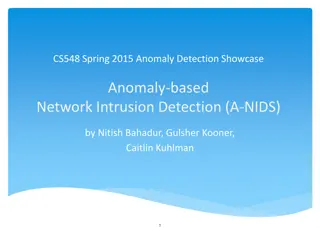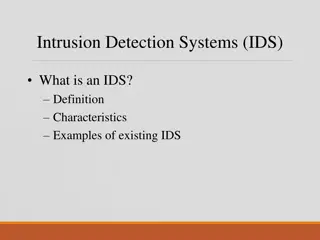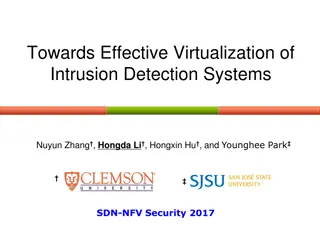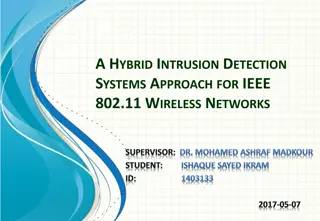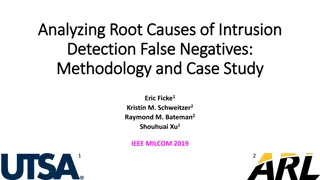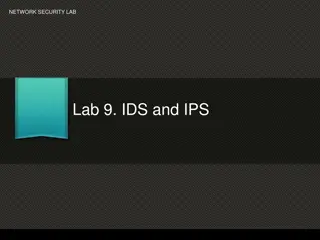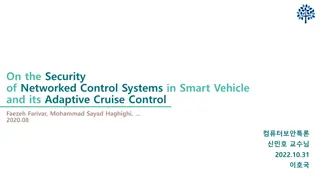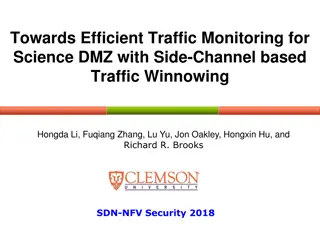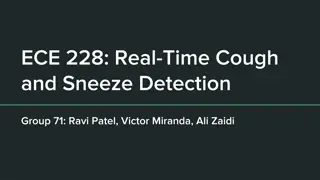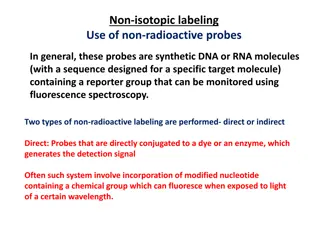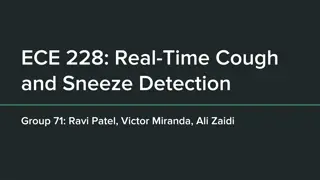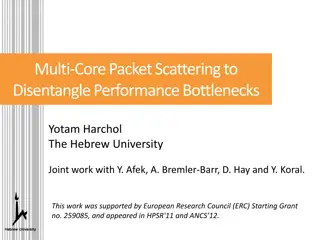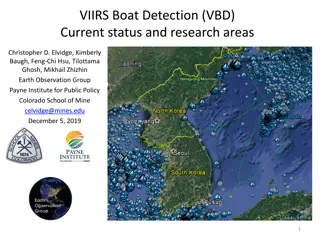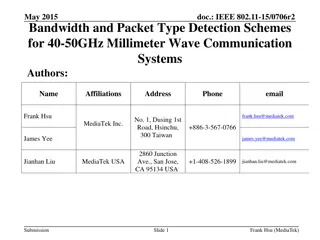Understanding Intrusion Detection and Prevention Systems
Learn about the components and implementation options of intrusion detection and prevention systems, as well as the goals and role of an IDPS in network defense. Discover the capabilities of IDPS, such as assessing network traffic, detecting unauthorized access, and responding to threats. Explore anomaly and signature detection systems and understand how they can help in identifying suspicious activities.
Uploaded on Sep 23, 2024 | 0 Views
Download Presentation

Please find below an Image/Link to download the presentation.
The content on the website is provided AS IS for your information and personal use only. It may not be sold, licensed, or shared on other websites without obtaining consent from the author. Download presentation by click this link. If you encounter any issues during the download, it is possible that the publisher has removed the file from their server.
E N D
Presentation Transcript
Intrusion Detection MIS.5213.011 ALTER 0A234 Lecture 3
Objectives Identify the components of an intrusion detection and prevention system Describe options for implementing intrusion detection and prevention systems Guide to Network Defense and Countermeasures, 3rd Edition 2
Goals of an IDPS Network intrusion Attempt to gain unauthorized access to network resources Intrusion Detection and Prevention System (IDPS) Consists of more than one application or hardware device Incorporates more than just detection Intrusion detection and prevention Involves prevention, detection, and response Guide to Network Defense and Countermeasures, 3rd Edition 3
The role of intrusion detection and prevention in network defense Guide to Network Defense and Countermeasures, 3rd Edition 4
Goals of an IDPS An IDPS should be able to: Assess large volumes of network traffic or system activity to find signs of unauthorized access Record its findings in a log so that administrators can examine past activity Detect and record unauthorized access without compromise to produce evidence admissible in court Respond almost immediately Make itself and systems it protects as inaccessible as possible to attackers Guide to Network Defense and Countermeasures, 3rd Edition 5
Anomaly and Signature Detection Systems Anomaly detection system: makes use of profiles that describe services and resources each authorized user normally accesses Network baselines are associated with profiles System can monitor profiles for suspicious activity that does not fit the profiles IDPS can create baselines by monitoring network traffic to observe what is considered normal behavior Guide to Network Defense and Countermeasures, 3rd Edition 6
Anomaly and Signature Detection Systems If profiles are incomplete or inaccurate: IDPS sends alarms that false positives (legitimate traffic rather than actual attacks) False negatives (genuine attacks that an IDPS does not detect) could occur True negatives: legitimate communications that do not set off an alarm True positive: used to describe a genuine attack that an IDPS detects successfully Guide to Network Defense and Countermeasures, 3rd Edition 7
Anomaly and Signature Detection Systems Signature detection: triggers alarms based on characteristic signatures of known external attacks Signature-based IDPS best for companies that want a basic IDPS and mostly concerned with known attacks Network engineers research well-known attacks and record rules associated with each signature Signatures should be updated regularly Guide to Network Defense and Countermeasures, 3rd Edition 8
Advantages and disadvantages of detection systems Guide to Network Defense and Countermeasures, 3rd Edition 9
Advantages and disadvantages of detection systems (continued) Guide to Network Defense and Countermeasures, 3rd Edition 10
Stateful Protocol Analysis Stateful protocol analysis: information gathering about a connection When an IDPS receives a packet, connection information between the host and remote computer is compared to entries in a state table State table: maintains a record of connections between computers Includes: source and destination IP address and port, and protocol Event horizon: entire length of the attack IDPS needs to maintain state information during this Guide to Network Defense and Countermeasures, 3rd Edition 11
Stateful Protocol Analysis Stateful protocol analysis approaches: Traffic rate monitoring If IDPS detects sudden increase in traffic it can stop and reset all TCP traffic Protocol state tracking IDPS maintains a record of connection s state and allows packets to pass through if it is an established connection Dynamic Application layer protocol analysis Can identify applications not using standard ports IP packet reassembly Can reassemble fragmented packets to prevent fragments from passing through to the internal network Guide to Network Defense and Countermeasures, 3rd Edition 12
Examining IDPS Components Components Network sensors or host-based agents Detection and prevention capabilities Command console Database server that stores attack signatures or behaviors Guide to Network Defense and Countermeasures, 3rd Edition 13
Sensors and Agents Sensor or agent Functions as electronic eyes of an IDPS Host-based IDPS IDPS installed on a single host computer has its agent built into the IDPS software Network-based IDPS sensor is hardware or software that monitors network traffic in real time Attacks detected by an IDPS sensor Single-session attacks isolated attempt Multiple-session attacks take place over a period of time Guide to Network Defense and Countermeasures, 3rd Edition 14
Sensors and Agents Sensors should be placed at common-entry points Internet gateways Connections between one network and another Remote access server that receives dial-up connections from remote users Virtual private network (VPN) devices Sensors could be positioned at either side of the firewall Behind the firewall is a more secure location IDPS management server: central repository for sensor and agent data Guide to Network Defense and Countermeasures, 3rd Edition 15
Positioning sensors at entry points to the network Guide to Network Defense and Countermeasures, 3rd Edition 16
Positioning sensors behind the firewall in the DMZ Guide to Network Defense and Countermeasures, 3rd Edition 17
Detection and Prevention Capabilities When selecting an IDPS, consider the following: Threshold Values that set the limit between normal and abnormal behavior Blacklists lists of entities that have been associated with malicious activity Whitelists lists of entities known to be harmless Alert settings specifying default priorities or severity levels, determining which prevention capabilities should be used for certain events, and specifying what information should be logged Guide to Network Defense and Countermeasures, 3rd Edition 18
Detection and Prevention Capabilities Prevention Capabilities IDPS can be configured to take preventative countermeasures Example: resetting all network connections when an intrusion is detected Some IDPSs allow administrators to specify which measure should be taken for each alert type Some have a simulation mode in which all prevention capabilities are disabled but generate reports used to fine- tune prevention capabilities Guide to Network Defense and Countermeasures, 3rd Edition 19
Command Console Provides a graphical front-end interface to an IDPS Enables administrators to receive and analyze alert messages and manage log files IDPS can collect information from security devices throughout a network Command console should run on a computer dedicated solely to the IDPS To maximize the speed of response Guide to Network Defense and Countermeasures, 3rd Edition 20
Database of Attack Signatures or Behaviors IDPSs do not have the capability to use judgment Can make use of a source of information for comparing the traffic they monitor Signature-detection IDPS Reference a database of known attack signatures If traffic matches a signature, it sends an alert Keep database updated Anomaly-based IDPS Store information about users in a database Guide to Network Defense and Countermeasures, 3rd Edition 21
The SecurityFocus online database of known vulnerabilities Guide to Network Defense and Countermeasures, 3rd Edition 22
Options for IDPSs Network-based IDPS Host-based IDPS Hybrid IDPS Guide to Network Defense and Countermeasures, 3rd Edition 23
Network-Based IDPSs Network-based IDPS (NIDPS) Monitors network traffic by using well-positioned sensors, management servers, a command console, and a signature database Can be hardware devices equipped with NICs for capturing and analyzing packets Can also be software-based sensors installed on a dedicated computer Positioning an NIDPS on the Network Behind the firewall and before the LAN Between the firewall and the DMZ Any network segment Guide to Network Defense and Countermeasures, 3rd Edition 24
Network-Based IDPSs An NIDPS can use: Inline sensors positioned so that network traffic must pass through it Used to stop attacks from blocking network traffic Usually placed where firewalls are positioned Passive sensors monitor copies of traffic; no actual traffic passes through them Can monitor traffic by: Spanning port Network tap IDPS load balancer Guide to Network Defense and Countermeasures, 3rd Edition 25
Positioning an inline sensor Guide to Network Defense and Countermeasures, 3rd Edition 26
Positioning a passive sensor Guide to Network Defense and Countermeasures, 3rd Edition 27
Network-Based IDPSs NIDPS Capabilities Vary depending on product Some can: Collect information about hosts, OSs, applications, and network activities and characteristics Used to help identify vulnerable hosts Analyze packet headers to identify unusual behavior Most have traffic logs to help identify and analyze potential attacks, locate vulnerabilities, and assess network use and performance Guide to Network Defense and Countermeasures, 3rd Edition 28
Network-Based IDPSs NIDPS prevention capabilities vary based on sensor types: Passive only Ends the current TCP session Inline only Uses inline firewalling and bandwidth throttling, and alters malicious content Passive and inline Reconfigures other network security devices Administrators can configure specific actions for each type of alert Guide to Network Defense and Countermeasures, 3rd Edition 29
Network-Based IDPSs NIDPS Management Designing architecture includes: Determining where sensors are located How many are needed and how they should be connected Testing NIDPS components includes: Accounting for network downtime while deploying sensors Securing components involves: Making sure sensors do not have IP addresses Hardening management networks and configuring hosts for log files and backups Guide to Network Defense and Countermeasures, 3rd Edition 30
Host-Based IDPSs Host-based IDPS (HIDPS) Deployed on hosts in the network perimeter Commonly use management servers, signature databases, and console Evaluates traffic generated by the host Often used to protect a Web server or database server Gathers system variables such as System processes, CPU use, file accesses, system logs, and system and application configuration changes Does not sniff packets as they enter the LAN Monitors log file entries and user activity Guide to Network Defense and Countermeasures, 3rd Edition 31
A typical HIDPS deployment Guide to Network Defense and Countermeasures, 3rd Edition 32
Host-Based IDPSs Configuring an HIDPS Centralized configuration HIDPS sends all data to a central location Host s level of performance is unaffected by the IDPS Alert messages that are generated do not occur in real time Distributed configuration Processing of events is distributed between host and console Host generates and analyzes it in real time Performance reduction in host Guide to Network Defense and Countermeasures, 3rd Edition 33
A centralized HIDPS Guide to Network Defense and Countermeasures, 3rd Edition 34
Processing event data from an HIDPS Guide to Network Defense and Countermeasures, 3rd Edition 35
Host-Based IDPSs Choosing the Host Centralized configuration RAM, hard disk memory, and processor speed requirements are minimal Distributed configuration Host should be equipped with maximum memory and processor speed Guide to Network Defense and Countermeasures, 3rd Edition 36
Comparing an NIDPS and HIDPS HIDPS Can tell whether an attack attempt was successful Can detect attacks that would get past NIDPS Provides only data pertaining to the host, not network as a whole Compares records stored in audit logs NIDPS Provides alerts on suspicious network activity Does not tell whether attack occurred Detects attacks on network Such as port scanning on a range of computers Guide to Network Defense and Countermeasures, 3rd Edition 37
Hybrid IDPSs Hybrid IDPS Combines the features of HIDPSs and NIDPSs Gains flexibility and increases security Combining IDPS Sensor Locations Put sensors on network segments and network hosts Can report attacks aimed at particular segments or the entire network Guide to Network Defense and Countermeasures, 3rd Edition 38
Hybrid IDPSs Combining IDPS Detection Methods IDPS combines anomaly and signature detection Database of known attack signatures enables IDPS to run immediately Anomaly-based systems keep the alert system flexible A hybrid IDPS that combines anomaly and signature detection can respond to both external and internal attacks Administrators have more configuration and coordination work to do Guide to Network Defense and Countermeasures, 3rd Edition 39
Hybrid IDPSs Advantages Combine aspects of NIDPS and HIDPS configurations Can monitor network as a whole Can monitor attacks that reach individual hosts Disadvantages Getting disparate systems to work in coordinate fashion Data gathered by multiple systems can be difficult to analyze Guide to Network Defense and Countermeasures, 3rd Edition 40
Securing IDPS Components IDPS must be able to handle the volume of traffic or activity it encounters IDPSs should be tested regularly Sensors should not be addressable Communication between IDPS components should be encrypted Authentication should be required for use and administration of the IDPS IDPSs should be able to work during DoS attacks Remote logging should be used in an HIDPS OSs of HIDPSs should be patched and hardened Guide to Network Defense and Countermeasures, 3rd Edition 41
Developing IDPS Filter Rules To create IDPS filter rules you must know basics of Snort rule syntax Snort rule has two sections: header and options Example: Alert tcp any any -> 192.16.21.0/24 111 (content: 00 01 86 a5 ; msg: mounted access ;) Header is the opening portion Options are in parentheses Guide to Network Defense and Countermeasures, 3rd Edition 42
Examining Intrusion Detection Step by Step Steps Installing the IDPS database Gathering data Sending alert messages The IDPS responds The administrator assesses damage Following escalation procedures Logging and reviewing events Guide to Network Defense and Countermeasures, 3rd Edition 43
Figure 8 Figure 8- -11 11 Steps in intrusion detection Guide to Network Defense and Countermeasures, 3rd Edition 44
Step 1: Installing the IDPS Database IDPS uses the database to compare traffic detected by sensors Anomaly-based systems Requires compiling a network baseline by observing network traffic (over a week) Signature-based IDPS Can use database immediately You can add your own custom rule base Guide to Network Defense and Countermeasures, 3rd Edition 45
Step 2: Gathering Data Network sensors gather data by reading packets Sensors need to be positioned where they can capture all packets Sensors on individual hosts capture information that enters and leaves the host Sensors on network segments read packets as they pass throughout the segment Sensors on network segments cannot capture all packets If traffic levels become too heavy Guide to Network Defense and Countermeasures, 3rd Edition 46
Step 3: Sending Alert Messages IDPS detection software compares captured packets with information in its database IDPS sends alert messages If captured packets match an attack signature or Deviates from normal network behavior Guide to Network Defense and Countermeasures, 3rd Edition 47
Step 4: The IDPS Responds Command console receives alert messages Notifies the administrator IDPS response actions: Alarm - Send an alarm message Drop Packet is dropped Reset IDPS stops and restarts network traffic Code analysis Prevents malicious code from running File system monitoring Prevent files from being modified Network traffic filtering act as firewall Network traffic analysis stop incoming traffic Guide to Network Defense and Countermeasures, 3rd Edition 48
Step 5: The Administrator Assesses Damage Administrator monitors alerts Determines whether countermeasures are needed Administrator need to fine-tune the database The goal is avoiding false negatives Line between acceptable and unacceptable network use is not always clear Guide to Network Defense and Countermeasures, 3rd Edition 49
Differentiating acceptable and unacceptable network use Guide to Network Defense and Countermeasures, 3rd Edition 50




